Birds of Florida
Ducks and Waterfowl
On this page - Common Moorhen, American Coot, Pied-billed Grebe, Florida Mottled Duck, Wood Duck, Double-crested Cormorant, Anhinga, Wood Stork
Common Moorhen - Gallinula chloropus
Family - Rallidae
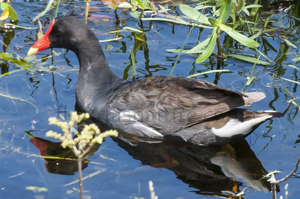
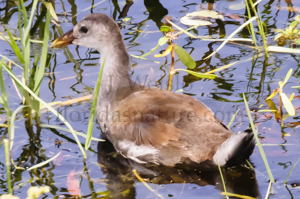
The Common Moorhen is a familiar bird throughout Florida, sometimes referred to as a Marsh Hen or Florida Gallinule. This bird can be found in marshes, ponds and lakes with plenty of submerged and emergent vegetation growing, where they feed on vegetation and small invertebrates.
Adults are easily distinguished by their bright red forehead and a red beak tipped with yellow, a black head and dark slate gray neck, sides and under parts, they have a brown back with a white stripe along their sides and the sides of the under-tail. Size - 14 inches.
Common Moorhens are excellent swimmers in spite of having no webbing on their toes, legs are orange above the knee, green below the knee. Juvenile's are brownish-gray with a drab reddish bill.
American Coot - Fulica americana
Family - Rallidae
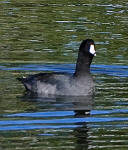
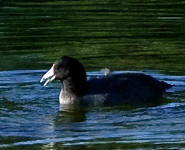
A common water bird throughout Florida and the North and South American continents, the American Coot is sometimes mistaken for a duck, however it is a member of the rail family (Rallidae). Size - 15 inches.
A triangular shaped beak and lack of webbed toes are the most obvious distinguishing physical characteristics between this bird and the ducks. Adults have a grey body with darker grey to almost black neck and head. The white bill is stout and has a dark band near the tip, although they don't have true webbing on their toes they do have lobes at each joint. During winter and non-breeding season Coots often group together to form large "rafts" for safety.
Pied-billed Grebe - Podilymbus podiceps
Family - Podicipedidae

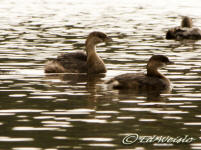
A small diving bird, the Pied-billed Grebe has a gray-brown head and body with lighter under parts and tufted tail. Juveniles and adults appear similar except during summer when adults have a black throat and white bill with a black band.
The Pied-billed grebe can be found on inland and coastal waterways, lakes and marshes throughout the year in Florida, being more plentiful in winter when the annual influx of migrants come south. In the summer breeding season they build a floating nest in thickets of emergent vegetation, attaching it to the surrounding plants in the shallow, quiet waters of freshwater marshes and ponds. Clutches consist of 3-10 bluish white eggs.
Pied-billed grebes will duck underwater at any sign of danger and are rarely seen in flight, preferring to be in the water. They can also move impressive distances underwater. Diet consists of small fish, snails, crayfish and aquatic insects.
Florida Mottled Duck - Anas fulvigula fulvigula
Family - Anatidae
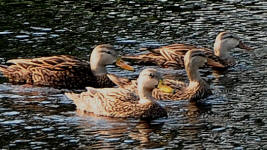
The Florida Mottled Duck is a unique subspecies and a non-migratory year-round resident of the Florida peninsula. This bird can be found inhabiting brackish and freshwater marshes, ponds and wet prairies. Size -22 inches.
Closely related to the Mallard, it can be easily mistaken for a female Mallard or a Black duck, in fact the Mottled duck bloodline is threatened by interbreeding with feral domesticated Mallards.
Most easily distinguished from the female Mallard by having a yellow bill whereas the Mallards bill is more orange with a darker saddle, the female Mallard also lacks the dark spot at the gape. A dabbler, their diet consists of small aquatic invertebrates, insects, as well as plant material such as grass seeds, stems and roots.
Wood Duck - Aix sponsa
Family - Anatidae
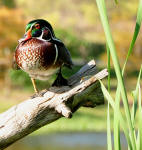
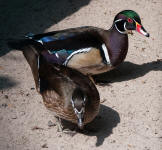
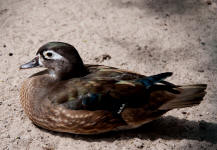
Considered to be the most colorful duck in Florida, the Wood duck is a dabbler found primarily in swamps and marshes.
Size - 19 inches. Male is iridescent with a dark purple back and chest, chest with white spots, head is green with swept back crest, buff colored sides and a white belly. Base of bill and eye ring are red, throat and chinstraps white, Female is brown with an elongated white eye ring.
Diet consists of seeds, acorns, fruits and invertebrates. Although there is a resident population Florida also gets many winter migrants from the northern U.S. and Canada.
Double-crested Cormorant - Phalacrocorax auritus
Family - Phalacrocoracidae

Florida has a resident breeding population of Cormorants in addition to numerous migratory birds from fall to spring.
The Double-crested Cormorant has an average body length of 33 inches, body is black with a faint green iridescent sheen, orange throat with a narrow hook tipped bill. This bird is found in coastal waters and lakes and ponds, often in the company of Anhinga or Herons. Nests in colonies in Mangroves or Cypress. Diet consists of fish, crustaceans, amphibians, snails.
Anhinga - Anhinga anhinga
Family - Anhingidae
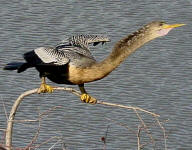
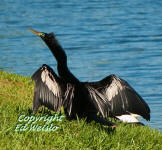
Also called the Water Turkey because of its large fan shaped tail or Snake Bird for its long neck, the Anhinga hunts fish underwater by diving and then spearing them with its long sharp bill. It then flips the fish around to swallow them head first & whole.
Anhinga feathers are not waterproof, helping this unique bird to submerge in order to hunt. However it also means that they become"waterlogged" and must dry themselves in order to be able to fly well, thus they are often seen perched on trees and other structures near the water with their wings spread out to dry.
Wood Stork - Mycteria americana
Family - Ciconiidae
_small.jpg)

Wood Storks are up to 35 inches long with an average wingspan of 66 inches.
The adults head and neck lack feathers, showing the black skin underneath. They have a long, thick, and slightly curved bill.
Considered an wetland indicator species, it has evolved to rely on very specific conditions.
A healthy population indicates that the habitat it is associated with is also considered healthy. Since it requires approximately 400 pounds of food to support itself and its hatchlings, the Wood stork times its breeding to coincide with the dry season when the receding waters of freshwater marshes force its prey fish into concentrated areas.
Feeling around with its long beak in shallow waters the Wood stork snaps up fish and other small aquatic animals.